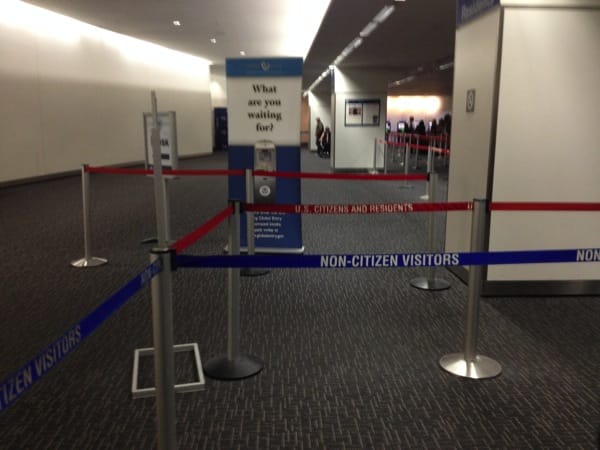
Hint: The future of air travel is not this
If you’re here, you were probably at my workshop on Developing Services with Service Blueprinting for UX Week 2014 or someone pointed you here.
By the end of the week, I’ll post my slides here, but for the moment, you can download the following: Update – The slides are here now too:
- The slides to my workshop presentation (41.6MB - sorry, lots of images)
- The handout cheatsheet (22.7MB)
- The brief (also below)
- The Blueprint Template (thanks to Tiziana from Launchlabs for creating this).
Some links
- A Rosenfeld quick panel on the UX of air travel for UX Mag.
- An article about the redesign of Gothenburg’s Landvetter airport. Note the security “lounge.”
- A video about service design for Helsinki airport
Brief: The future of air travel
From its early days of luxury for the few, air travel has become commonplace. Cheaper fares from low-budget airlines have made air travel as affordable as taking the train, sometimes more so. At the same time, security theatre and the complexity of multiple third-party services have made flying a series of irritations that lead to a frustrating experience. We rush from one stage to the next only to wait around for ages. We are sold poor quality food at high prices and directed through duty-free shopping malls to appease our boredom and encourage us to consume. Airports have lost any sense of adventure and engaging experience they once had. As fuel prices will inevitably rise, it is clear that the days of budget air travel are numbered. What happens then?
You brief is simple: reinvent the experience of air travel for 2030. This is just 16 years from now, so no flying cars or Star Trek transporters, but enough time for innovations in communications and customer experiences, as well as the reduction of resource consumption, to become the norm.
Here are some questions to get you started:
- What kind of experience should your service be? Start there and focus on a couple of key touchpoints to begin with. Then expand outwards.
- What are the highs and lows of air travel? Where are the cracks between the different elements of the services?
- How could transitions between stages and across channels be improved or reinvented?
- What elements are considered the norm but could be reimagined?
- What kind of experiences, services or paradigms could you borrow from another sector and apply here (e.g., what would be the IKEA or the Airbnb of air travel?)
The brief itself is really just a vehicle for you to get your minds around service design blueprinting and to use some of the methods, but it is much easier to learn this by doing rather than by just hearing about it.
Here is what would be good to try and achieve today:
- Some quick and dirty insights research (go out and speak to people, use your social networks).
- The logline. A one line headline and a brief introductory description of what your concept is.
- Create a service blueprint that details how people may use the service across relevant channels and touchpoints. What backstage elements need to be in place?
- Visualise how the service might appear in key touchpoints as a storyboard or sequence of sketches
- Pitch the idea in a three-minute presentation
The short URL for this page is http://pln.me/uxweek14

